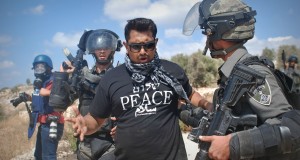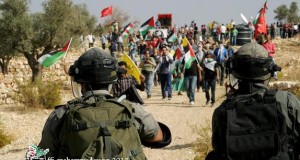23rd November 2014 | International Solidarity Movement | Bil’in, Occupied Palestine The Bil’in Popular Committee would like to thank everyone who supported Ibrahim Abu-Rahma, the 15-year-old boy who was arrested on September 14th while walking to school. A military judge ruled that he could ...
Read More »Human Rights Defender Abdallah Abu Rahma receives guilty verdict from military court
21st October 2014 | International Solidarity Movement | Bil’in, Occupied Palestine On October 21st, Human Rights Defender Abdallah Abu Rahma was found guilty by an Israeli military court of “disturbing a soldier”. “Demonstrating against the occupation cannot be a criminal offence. Finding ...
Read More »Action alert: Arrested on the way to school in Bil’in
23rd September 2013 | International Solidarity Movement | Bil’in, Occupied Palestine On September 14th at 11:00 in the morning, 15 year-old Ibrahim Abu-Rahma was walking to school with his little brother, 13-year-old Ahmed, in their village of Bil’in. An Israeli army jeep had infiltrated ...
Read More »Tear gas, rubber-coated steel bullets, and arrests
19th September 2013 | International Solidarity Movement | Occupied Palestine Every week, several villages across the West Bank demonstrate against the Israeli occupation of Palestine. This week, ISM activists attended protests in the villages of Bil’in, Ni’lin, and Nabi Saleh. During the demonstration ...
Read More »Two activists arrested during Bil’in protest
In celebration of victory in Gaza, and the thirteenth anniversary of the martyrdom of Abu Ali Mustafa this week, two activists were arrested at the Bil’in demonstration. Further to this dozens of demonstrators suffered from inhalation of tear gas. The demonstration ...
Read More »Photo story: Prisoner solidarity protest in village of Bil’in
13th June 2014 | International Solidarity Movement, Ramallah team | Bil’in, Occupied Palestine Today, Bil’in held its weekly protest in solidarity with the Palestinian prisoners on hunger strike. As part of the protest, and in support of the current situation in ...
Read More »Two people were injured and dozens more suffered from tear gas inhalation at weekly demonstration in Bil’in
24th January 2014 | FFJ Media Center | Bil’in, Occupied Palestine Two people were injured and dozens of other civilians, including international solidarity supporters, suffered from tear gas inhalation during Bil’in’s weekly protest against the wall and settlements. This week, ...
Read More »Several injuries during Bi’lin weekly demonstration
16th October 2013 | Friends of Freedom and Justice | Bil’in, Occupied Palestine Yesterday during the weekly Bi’lin demonstration, an Egyptian photographer was injured after being shot by a tear gas canister in his back, Ismaeil Mohamed Abu Rahma (17-years-old) was shot ...
Read More »Three Palestinians injured by Israeli forces during weekly protest in Bil’in.
1st November 2013 | FFJ media center | Bil’in, Palestine This Friday, October the 1st, Bil’in’s weekly peaceful demonstration has once again been a violent demonstration from the Israeli state, while live ammunition and huge quantities of tear gas have ...
Read More »Bil’in continue their weekly demonstration against the occupation
12th October 2013 | Friends of Freedom and Justice | Bil’in, Occupied Palestine Yesterday, 11th October, Israeli soldiers fired tear gas canisters at a Palestinian family while they were attempting to harvest their olives. This coincided with the weekly Bil’in demonstration against ...
Read More » International Solidarity Movement Nonviolence. Justice. Freedom.
International Solidarity Movement Nonviolence. Justice. Freedom.








